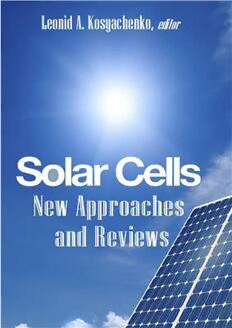
Solar Cells: New Approaches and Reviews PDF
Preview Solar Cells: New Approaches and Reviews
Solar Cells New Approaches and Reviews Edited by Leonid A. Kosyachenko Solar Cells: New Approaches and Reviews Edited by Leonid A. Kosyachenko Published by AvE4EvA Copyright © 2015 All chapters are Open Access distributed under the Creative Commons Attribution 3.0 license, which allows users to download, copy and build upon published articles even for commercial purposes, as long as the author and publisher are properly credited, which ensures maximum dissemination and a wider impact of our publications. After this work has been published, authors have the right to republish it, in whole or part, in any publication of which they are the author, and to make other personal use of the work. Any republication, referencing or personal use of the work must explicitly identify the original source. As for readers, this license allows users to download, copy and build upon published chapters even for commercial purposes, as long as the author and publisher are properly credited, which ensures maximum dissemination and a wider impact of our publications. Notice Statements and opinions expressed in the chapters are these of the individual contributors and not necessarily those of the editors or publisher. No responsibility is accepted for the accuracy of information contained in the published chapters. The publisher assumes no responsibility for any damage or injury to persons or property arising out of the use of any materials, instructions, methods or ideas contained in the book. Publishing Process Manager Technical Editor AvE4EvA MuViMix Records Cover Designer Published: 22 October, 2015 ISBN-10: 953-51-2184-7 ISBN-13: 978-953-51-2184-8 C ontents Preface Chapter 1 A Theoretical Description of Thin-Film Cu(In,Ga)Se2 Solar Cell Performance by Leonid A. Kosyachenko Chapter 2 Theoretical Calculation of the Efficiency Limit for Solar Cells by Abderrahmane Belghachi Chapter 3 Crystal Structures of CH3NH3PbI3 and Related Perovskite Compounds Used for Solar Cells by Takeo Oku Chapter 4 New Approaches to Practical High-Effective Solar Energy Conversion by Viktor I. Laptev and Halyna Khlyap Chapter 5 Towards 50% Efficiency in Solar Cells by Luis M. Hernández, Armando Contreras-Solorio, Agustín Enciso, Carlos I. Cabrera, Maykel Courel, James P. Connolly and Julio C. Rimada Chapter 6 Solar Cell Efficiency Increase at High Solar Concentration, by Thermionic Escape via Tuned Lattice-Matched Superlattices by A.C. Varonides Chapter 7 Deep Level Transient Spectroscopy: A Powerful Experimental Technique for Understanding the Physics and Engineering of Photo-Carrier Generation, Escape, Loss and Collection Processes in Photovoltaic Materials by Aurangzeb Khan and Yamaguchi Masafumi Chapter 8 Inorganic–Organic Perovskite Solar Cells by Sohrab Ahmadi Kandjani, Soghra Mirershadi and Arash Nikniaz VI Contents Chapter 9 The Physics of High-Efficiency Thin-Film III-V Solar Cells by Roger E. Welser, Ashok K. Sood, Ramesh B. Laghumavarapu, Diana L. Huffaker, David M. Wilt, Nibir K. Dhar and Kimberly A. Sablon Chapter 10 Crystalline Silicon Solar Cells with Nickel/Copper Contacts by Atteq ur Rehman and Soo Hong Lee Chapter 11 Quantum Dots Solar Cells by Khalil Ebrahim Jasim Chapter 12 Solar Cells with InGaN/GaN and InP/InGaAsP and InGaP/ GaAs Multiple Quantum Wells by Shaoguang Dong, Kanghua Chen, Guojie Chen and Xin Chen Chapter 13 Bulk Heterojunction Solar Cells — Opportunities and Challenges by Qun Ye and Jian Wei Xu Preface This book contains chapters in which the problems of modern photovoltaics are considered. The majority of the chapters provide an overview of the results of research and development of different types of solar cells. Such chapters are completed by a justification for a new solar cell structure and technology. Of course, highly effective solar energy conversion is impossible without an in-depth examination of the solar cell components as physical materials. The relations between structural, thermodynamic, and optical properties of the physical material without addressing the band theory of solids are of both theoretical and practical interest. Requirements formulated for the material are also to be used for maximally efficient conversion of solar radiation into useful work. Chapter 1 A Theoretical Description of Thin-Film Cu(In,Ga)Se Solar 2 Cell Performance Leonid A. Kosyachenko Additional information is available at the end of the chapter http://dx.doi.org/10.5772/59363 1. Introduction For a long time, solar cells based on CuIn GaSe (Cu(In,Ga)Se, CIGS), similar to CdTe-based 1-x x 2 2 devices, keep a stable position in thin-film photovoltaics as an alternative to solar modules based on mono- and poly-silicon wafers. The I-III-VI CIGS alloy is a solid solution of copper indium diselenide (CIS) and copper gallium diselenide (CGS). This alloy is tolerant in terms of material stability and miscibility in a wide range of x, when the semiconductor bandgap varies continuously from about 1.0 eV for CIS to about 1.65 eV for CGS. Irrespective of the material composition, CIGS is a direct-bandgap semiconductor and strongly absorbs sunlight. Because of its high optical absorption coefficient, a much thinner film is required compared to many other semiconductor materials (1–2 μm is enough to absorb most of the sunlight). To date, mass production of cost-effective thin-film polycrystalline and monolithically interconnected CIGS-based modules has been achieved by many companies worldwide. Since 2007, one Japanese company Solar Frontier, alone for example, delivered over 1 GW CIGS modules. The CIGS devices demonstrate excellent long-term stability; can be fabricated on lightweight and flexible substrates that are desirable for portable, building-integrated photo‐ voltaics and many other applications when solar panels are used to replace conventional building materials in parts of the roof or facades. It should also be noted that the CIGS modules, in addition to their long-term stability, have shown higher resistance to ionizing radiation compared to crystalline Si and III-V solar cells, i.e., such devices are promising for space application [1]. The energy conversion efficiency of CIGS modules is in the range of 12-15%, but for small area laboratory cells, the efficiency milestone of > 20% was achieved in 2010 [2]. In 2014, Solar Frontier has achieved 20.8% energy conversion efficiency for small area CIGS cells and Zentrum für Sonnenenergie-und Wasserstoff-Forschung Baden-Württemberg (ZSW) shortly
